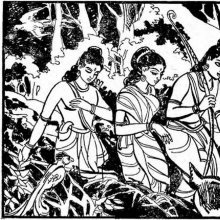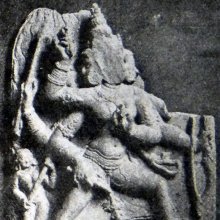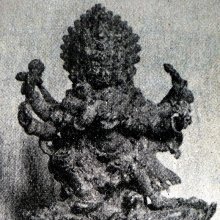Terror: 1 definition
Introduction:
Terror means something in Hinduism, Sanskrit. If you want to know the exact meaning, history, etymology or English translation of this term then check out the descriptions on this page. Add your comment or reference to a book if you want to contribute to this summary article.
Images (photo gallery)
In Hinduism
Natyashastra (theatrics and dramaturgy)
Source: Shodhganga: Elements of Art and Architecture in the Trtiyakhanda of the Visnudharmottarapurana (natya)1) Walking in Terror is associated with Śīghra-gati: one of the various Gatis (“way of walking”) (in Indian Dramas), according to the Viṣṇudharmottarapurāṇa, an ancient Sanskrit text which (being encyclopedic in nature) deals with a variety of cultural topics such as arts, architecture, music, grammar and astronomy.—Śīghragati or quick gait should be adopted in fear, terror, anger, joy, rapid and urgent actions, on hearing distasteful information, on seeing unbelievable things, searching of crime factors etc. In the Mṛcchakaṭika of Śudraka, the heroin Vasantasenā was moving speedily in terror as she was followed by some cunning persons like Vīṭa, Ceṭa and Śakāra and her gait was crossing over the speed of wind. This can be taken as a manifestation of śīghra-gati.
2) Terror is associated with Mṛgaśīrṣa-hasta: one of the twenty-two Single-hand Gestures (in Indian Dramas) (known as asaṃyuktahastas).—The word mṛgaśīrṣa is the union of two words viz., mṛga and śīrṣa. The word mṛga means deer and śīrṣa means head. So, it can be said that the hand posture which is called mṛgaśīrṣa identifies a posture that looks like the head of a deer. [...] In the Abhinayadarpaṇa, the mṛgaśīrṣa-hasta posture is used to denote various things. This book states that this posture is used to show woman, cheek, wheel, limit, terror, quarrel, attire and to call someone or the beloved, the lute, foot massage, female organ, holding umbrella etc.

Natyashastra (नाट्यशास्त्र, nāṭyaśāstra) refers to both the ancient Indian tradition (shastra) of performing arts, (natya—theatrics, drama, dance, music), as well as the name of a Sanskrit work dealing with these subjects. It also teaches the rules for composing Dramatic plays (nataka), construction and performance of Theater, and Poetic works (kavya).
See also (Relevant definitions)
Full-text (+399): Bhiti, Santrasa, Vibhishika, Sadhvasa, Bhaya, Trasa, Bhishana, Uttrasa, Bhairava, Calakampa, Utrasa, Cirika, Ghabara, Samudvega, Akheta, Ghabaranem, Apatras, Bhita, Darad, Shanka.
Relevant text
Search found 171 books and stories containing Terror; (plurals include: Terrors). You can also click to the full overview containing English textual excerpts. Below are direct links for the most relevant articles:
The Vishnu Purana (by Horace Hayman Wilson)
Chapter XVI - Slaughter demon Keshin < [Book V]
Chapter XIV - Slaughter demon Arishta, disguished as a savage bull (Vrishabha) < [Book V]
Chapter IV - Freedom from imprisonment < [Book V]
Mahabharata (English) (by Kisari Mohan Ganguli)
Section CC < [Markandeya-Samasya Parva]
Section CLXXXVII < [Drona-vadha Parva]
Section C < [Bhagavat-Gita Parva]
Manusmriti with the Commentary of Medhatithi (by Ganganatha Jha)
Verse 12.77 < [Section IX - Details of Transmigration]
Verse 9.248 < [Section XXXIII - Disposal of the Fine realised from the Worst Offenders]
Verse 8.347 < [Section XLV - Violence (hiṃsā)]
Abhidhamma in Daily Life (by Nina Van Gorkom)
Visuddhimagga (the pah of purification) (by Ñāṇamoli Bhikkhu)
Insight (4): Knowledge of Danger < [Chapter XXI - Purification by Knowledge and Vision of the Way]
Insight (3): Knowledge of Appearance as Terror < [Chapter XXI - Purification by Knowledge and Vision of the Way]
Insight (5): Knowledge of Dispassion < [Chapter XXI - Purification by Knowledge and Vision of the Way]



